Figures & data
Table 1. Characteristics of participants.
Table 2. Mean (standard deviation) descriptive statistics for target and probe stimuli in morphological, pseudo-morphological, semantic, and unrelated conditions.
Figure 1. Typically developing novice, intermediate, and advanced readers’ sensitivity (d') to the presence of the probe on the list when a target word shared morphological, pseudo-morphological, or semantic overlap, or was unrelated. Note. Error bars indicate standard error.

Figure 2. Children with a history of repeated ear infection (otitis media [OM]), reading age (RA), and chronological age (CA) matched typically developing readers’ sensitivity (d') to the presence of the probe on the list when a target word shared morphological, pseudo-morphological, or semantic overlap, or was unrelated. Note. Error bars indicate standard error.
![Figure 2. Children with a history of repeated ear infection (otitis media [OM]), reading age (RA), and chronological age (CA) matched typically developing readers’ sensitivity (d') to the presence of the probe on the list when a target word shared morphological, pseudo-morphological, or semantic overlap, or was unrelated. Note. Error bars indicate standard error.](/cms/asset/7521e570-9b13-4e8e-b237-e226dd01cc0f/hssr_a_1246554_f0002_b.gif)
Figure 3. Dyslexic, reading-age- (RA) and chronological-age- (CA) matched typically developing readers’ sensitivity (d') to the presence of the probe on the list when a target word shared morphological, pseudo-morphological, or semantic overlap, or was unrelated. Note. Error bars indicate standard error.

Table A1. Stimuli.
